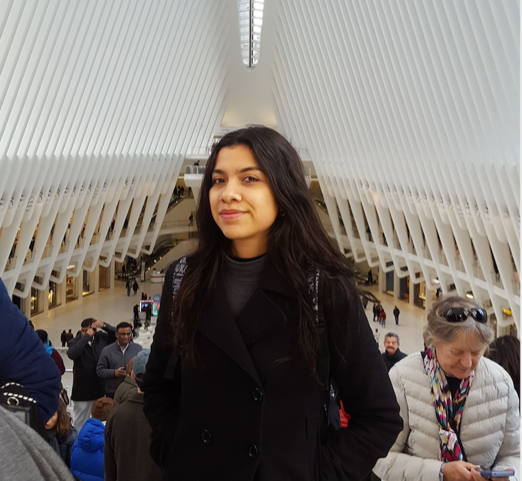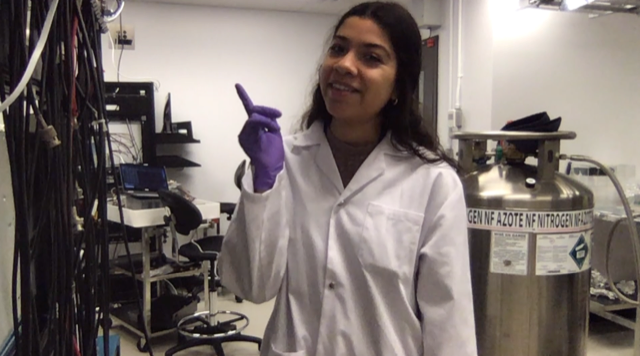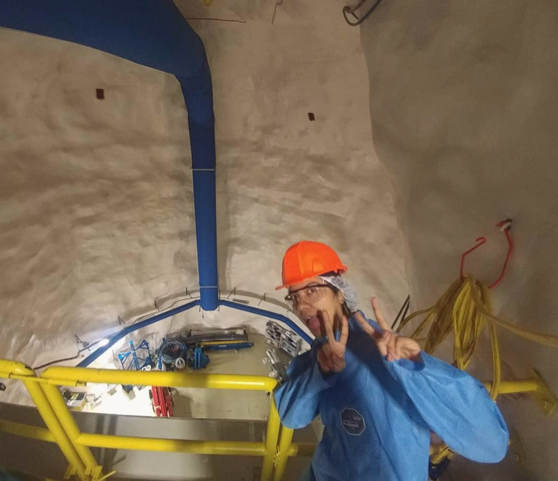Melissa Medina-Peregrina
McGill University
MSc Candidate - Experimental Nuclear Physics
Melissa Medina-Peregrina is an MSc candidate at McGill University working on the development of an In-Xe-gas Laser Ablation Source for the Ba-tagging technique for the nEXO experiment under Prof. Thomas Brunner.
Contact Information:
Email: melissa.medinaperegrina@mail.mcgill.ca
McGill website: https://www.physics.mcgill.ca/~medina/

Bio
I got interested in Nuclear Physics after participating in a summer program (2015) at the Irradiation Unit of the Nuclear Sciences Institute of UNAM in Mexico City.
Furthermore, I did an academic exchange to the University of Perugia in Italy. For my project, I analyzed data obtained from Silicon Photomultipliers to characterize them for the construction of the Cherenkov Telescope Array. I also participated in the Neutronic Spectroscopy Summer School 2016 organized by the Italian Society of Neutron Spectroscopy. I visited the Laue-Langevin Institute and gave a short talk about the IN13 experiment, a thermal neutron backscattering spectrometer.
After obtaining my B.Sc. in Physics degree from the Autonomous University of Baja California in 2017, I attended to the 2nd Radio-Astrophysics Workshop at the National Institute of Astrophysics, Optics and Electronics in Tonanzintla, Mexico, where I analyzed data recovered from the Large Millimeter Telescope to obtain the stellar formation e ciency in the early universe.
I am currently a second year M.Sc. in Physics student at McGill University in Montreal, Canada. I am also the VP Professional Development of the McGill Graduate Association of Physics Students and the Scientific Program Coordinator of the International Conference of Physics Students Puebla 2020.

Q&A with Melissa
What are your research interests?
My research interests are focused in experimental nuclear physics, in particular neutrino physics.
How would you describe your work at the most basic level?
The new Enriched Xenon Observatory (nEXO) experiment is a 5-tonne liquid xenon aiming to observe for the first time neutrinoless double beta decay in the isotope Xe-136. An observation of this event would not only imply lepton number violation, a crucial result for the constitution of the standard model of particle physics, but could also answer questions about the matter-antimatter asymmetry of the universe, studied by cosmologists for more than a century. In order to increase nEXO’s sensitivity and to verify a potential signal as double-beta decay events, our collaboration is developing a Ba-tagging technique in which it is possible to identify the Xenon-136 decay daughter, Barium-136. When a candidate event is detected, the decay volume is searched for the presence of Ba and if found, the event can be identi ed as a double beta decay of Xe-136 and backgrounds that do not produce Ba, can be discarded. The Ba-tagging technique extracts ions from liquid Xe into a gaseous environment and subsequently into vacuum for final identification of the Ba ion. This process will be developed using a laser ablation ion source operated in gaseous Xe through a pressure chamber containing a sample target. When ablated, this target will provide large numbers of ions to study and optimize the ion extraction process, leading to a background reduction. To characterize the identification events, analysis of the laser transmission efficiency, current, energy, power and spatial resolution measurements from the ablated ions, are required.
Why did you choose physics?
I chose to study physics during high school when participating in physics olympiads. I attended the training sessions in what would after be my alma mater and I turned fascinated.
How does your collaboration with your key research facility partners work?
Since the Brunner Neutrino Group at McGill University is part of the nEXO collaboration, it has developed a strong cooperation with international universities and research centers, such as SNOLAB, TRIUMF, University of Ottawa, Stanford University, the Lawrence Livermore National Laboratory, among others. This increases research’s quality, promotes interdisciplinary, the exchange of new ideas, brings experience, responsibility, teamwork skills and a strong improvement of knowledge to the students.
What is something that might surprise others?
Some of my hobbies are listening to music, traveling, satisfying my sweet tooth and learning languages!

